-
Posts
3,517 -
Joined
-
Last visited
-
Days Won
27
Content Type
Profiles
Forums
Blogs
Gallery
Events
Store
Posts posted by bigjarofwasps
-
-
Officer honoured for his clifftop heroism
A heroic detective is to be honoured for his bravery after saving the life of a motorist who tried to drive over a cliff.
Detective Chief Inspector Adam Hibbert, 37, opened the car door and grabbed the ignition keys as the vehicle neared the 150ft drop at Telscombe Cliffs, east of Brighton.
He held on to the driver until other officers and firefighters came to his aid.
Police officers had been negotiating with the man for almost two hours when Mr Hibbert arrived.
The man had twice tried to drive through a fence and was about to try again when police made a dash to stop him.
Temporary Sergeant James Bowen tried to smash the windscreen with his baton before Mr Hibbert made his move.
Mr Hibbert realised the van was unlocked and as the man attempted to drive over the edge he grabbed the door handle and forced his way into the van despite the man's attempts to stop him.
He threw himself at the driver to break his grip on the wheel and pulled the keys from the ignition.
Mr Hibbert struggled with the man before he was able to take the van out of gear and put the handbrake on.
He restrained the man until assistance arrived.
Mr Hibbert, who has 15 years of service, said: "I was shaking a bit when I thought about what could have happened.
"The consequences don't bear thinking about.
"Looking back, it was very frightening.
"Not only did we want to save the life of this man, who was clearly distressed, but we had to think about the risks to ourselves.
"If the fence had given way at any point, he would undoubtedly have killed himself.
"James and I literally had milliseconds to think about what to do.
"James tried to smash the windscreen with his baton but it just wouldn't break.
"Then I noticed the locks were up so I just went for it and pulled the door open.
"I know it sounds a cliche but you don't think about the danger. You just get on and do the job."
The man, in his mid 30s, was detained under the Mental Health Act and taken to Brighton police station for his own safety following his rescue last November.
Mr Hibbert will be visiting 10 Downing Street next Thursday before attending the 10th annual Police Federation Awards at London's Dorchester Hotel.
Home Secretary Charles Clarke will honour officers, from 43 forces in England and Wales, for going above and beyond the call of duty.
Brian Stockham, chairman of the Police Federation's Sussex branch, said: "Apart from the courage required in this incident, Adam's actions were an example of inspired and inspiring leadership.
"Usually - and on an almost daily basis - our officers are expected to perform such acts and most often it is our constables and sergeants who are recognised for doing so.
"As well as personal courage, officers rely on years of training and experience to do these things in the finest traditions of the police service and to do them right as Adam did."
Mr Hibbert has had a mixed week - his house was burgled while he and his wife were out.
He said: "They turned the place upside down and stole electrical equipment, a stereo and clothes.
"I went to have a shave yesterday and found they'd even taken my razor."
https://www.theargus.co.uk/news/6702846.amp/
0 -
THE MURDER MANUAL –
AN INVESTIGATION INTO THE INVESTIGATION OF MURDER
Join senior crime scene officers from Sussex police as they deal with a bloody homicide, creating a crime scene and gathering evidence from statements, surveillance and forensics. See the reality of how they deal with witnesses, the family and the community – especially in that first golden hour, where every second counts if you want to break the case.
Presented by crime writer P.D. Viner, you will be led through the murder manual by top police officers. This is not fiction, this is where science is a matter of life and death.
Adam Hibbert is a Detective Superintendent, Head of Surrey and Sussex Major Crime Team, has led over 30 homicide investigations.
Trevor Bowles spent 5 years as a Senior Investigating Officer, leading 16 homicide investigationshttp://www.brightonscience.com/events/murder-manual/
0 -
Just came across this medal, not seen it before.
Thought it might be of interest?
http://www.nationalcrimeagency.gov.uk/
https://en.wikipedia.org/wiki/National_Crime_Agency_Long_Service_and_Good_Conduct_Medal
Has anyone got one in their collection?
0 -
April 2012 Nigerian girls may have been trafficked into the UK....
https://www.bbc.co.uk/news/uk-england-sussex-17691957
May 2014 - Chief Inspector jailed for fraud
https://www.getsurrey.co.uk/news/surrey-news/former-surrey-police-chief-inspector-7077323
July 2015 - Murder arrest over West Sussex suspected road rage incident............
https://www.bbc.co.uk/news/uk-england-sussex-33571051
https://www.bbc.co.uk/news/uk-england-sussex-33562606
June 2016 - Deepcut soldiers death was suicide..........
https://www.bbc.co.uk/news/uk-england-surrey-36438786
https://www.itv.com/news/update/2016-06-03/surrey-police-were-sorry-for-inquest-mistakes/
July 2016 Body found in Thames sparks murder investigation...
https://www.getsurrey.co.uk/news/surrey-news/walton-death-community-reacts-after-11682742
https://www.getsurrey.co.uk/news/surrey-news/walton-death-sees-man-arrested-11683480
https://www.getsurrey.co.uk/news/surrey-news/walton-murder-probe-man-freed-11685313
June 2017 Shoreham air crash disaster police probe 95% complete...........
https://www.bbc.co.uk/news/uk-england-sussex-40342625
April 2018 Worthing murder probe after two found dead in house....
https://www.bbc.co.uk/news/uk-england-sussex-43754465
https://www.bbc.co.uk/news/uk-england-sussex-43774579
https://www.theguardian.com/uk-news/2018/apr/13/man-and-woman-found-dead-in-worthing
0 -
January 2009 - Man arrested after fatal stabbing......
http://news.bbc.co.uk/1/hi/england/sussex/7862459.stm
http://news.bbc.co.uk/1/hi/england/sussex/7863896.stm
April 2009 - Babes in the wood father arrested.....
https://www.liverpoolecho.co.uk/news/liverpool-news/father-babes-wood-murder-victim-3417690
October 2009 - women's fire death unexplained.....
http://news.bbc.co.uk/1/hi/england/sussex/8310053.stm
http://news.bbc.co.uk/1/hi/england/sussex/8312162.stm
http://news.bbc.co.uk/1/hi/england/sussex/8314408.stm
January 2010 - Father charged with daughters murder dies in jail..........
http://news.bbc.co.uk/1/hi/england/sussex/8438921.stm
February 2010 - Ceiling of blood body find leads to man hunt.....
http://news.bbc.co.uk/1/hi/england/sussex/8493598.stm
http://news.bbc.co.uk/1/hi/england/sussex/8499209.stm
http://news.bbc.co.uk/1/hi/england/sussex/8506836.stm
http://news.bbc.co.uk/1/hi/england/sussex/8500787.stm
June 2010 - Brighton man jailed for Andrea Waddell murder...........
https://www.bbc.co.uk/news/10237293
October 2010 Julian Gardener Sussex Farm murder............
https://www.bbc.co.uk/news/uk-england-sussex-11513671
https://www.bbc.co.uk/news/uk-england-11861253
https://www.bbc.co.uk/news/uk-england-12013262
November 2010 - Brighton prostitute killer sentenced for earlier rape....
https://www.bbc.co.uk/news/uk-england-sussex-11810650
June 2011 Two jailed over Seaford Moon of India waiter murder....
https://www.bbc.co.uk/news/uk-england-sussex-13735251
https://www.bbc.co.uk/news/uk-england-sussex-13719667
0 -
February 2008 - Leaflet appeal for missing woman.....
http://news.bbc.co.uk/1/hi/england/sussex/7259558.stm
http://news.bbc.co.uk/1/hi/england/sussex/7263625.stm
http://news.bbc.co.uk/1/hi/england/sussex/7283011.stm
http://news.bbc.co.uk/1/hi/england/sussex/7322079.stm
http://news.bbc.co.uk/1/hi/england/sussex/7298095.stm
April 2008 - Meat cleaver pair jailed.....
http://news.bbc.co.uk/1/hi/england/sussex/7342649.stm
http://news.bbc.co.uk/1/hi/england/sussex/7341748.stm
May 2008- Husband gulity of roof box murder.......
http://news.bbc.co.uk/1/hi/england/sussex/7400914.stm
http://news.bbc.co.uk/1/hi/england/sussex/7161449.stm
October 2008 - Skull and bones found in Hastings wood......
http://news.bbc.co.uk/1/hi/england/sussex/7671788.stm
http://news.bbc.co.uk/1/hi/england/sussex/7677956.stm
0 -
November 2005 - Murder hunt for 'chav' daughter....
http://news.bbc.co.uk/1/hi/england/southern_counties/4413850.stm
http://news.bbc.co.uk/1/hi/england/southern_counties/4417518.stm
March 2006 Serial Killer convicted of murder.....
http://news.bbc.co.uk/1/hi/england/southern_counties/4813234.stm
http://courtnewsuk.co.uk/daniel-gonzalez/
October 2006 - wife murderer given life......
http://news.bbc.co.uk/1/hi/england/southern_counties/5406692.stm
July 2007 - search for father as boy found.............
http://news.bbc.co.uk/1/hi/england/sussex/6739653.stm
http://news.bbc.co.uk/1/hi/england/6743679.stm
July 2007 - Teenagers held over caravan death..............
http://news.bbc.co.uk/1/hi/england/sussex/6260096.stm
http://news.bbc.co.uk/1/hi/england/sussex/6277908.stm
http://news.bbc.co.uk/1/hi/england/sussex/6280448.stm
December 2007 - Violent deaths of couple probed.............
http://news.bbc.co.uk/1/hi/england/sussex/7160034.stm
0 -
April 2005 - A woman found dead after a fire in a hostel may have been murdered before the fire started, police believe....
http://news.bbc.co.uk/1/hi/england/southern_counties/4483859.stm
July 2005 - Bravery award for heroic officer.......
http://news.bbc.co.uk/1/hi/england/southern_counties/4684537.stm
August 2005 - Policeman arrested over death of son......
https://www.theguardian.com/uk/2005/aug/20/1
September 2005 - Hunt for missing 14 year old girl.......
http://news.bbc.co.uk/1/hi/england/southern_counties/4263494.stm
http://news.bbc.co.uk/1/hi/england/southern_counties/4275488.stm
http://news.bbc.co.uk/1/hi/england/southern_counties/4290562.stm
October 2005 - Family joy as missing 14 year old girl found.....
http://news.bbc.co.uk/1/hi/england/southern_counties/4376606.stm
0 -
Have recently been lucky enough to add these medals to my collection. My initial interest in the medal group was the fact that there were two LSGC's awarded to the same person I had not come across this before. There wasn't very much information in the right up, so I decided to contact the seller to see if they could shine any more light on the medals. The story that unfolded was very interesting to say the least, so I thought I'd share it on the forum.
The medal group consists of,
2002 Golden Jubilee Medal
2012 Diamond Jubilee Medal
Police Long Service & Good Conduct Medal to Insp Adam HIBBERT
Police Long Service & Good Conduct Medal to Ch Insp Adam HIBBERT
It appears he was awarded two LSGC's due to an administrative error.
Adam HIBBERT joined the Sussex Police in September 1987 and retired in September 2018. This being the first time the medals have been on the open market. Bought from the man himself!!
He certainly had a very interesting 30 year career with Sussex Police and was head of their homicide department.
He oversaw the investigation of over 30 murders and was headline news on more than one occasion.
He was also involved in several other interesting cases and was also given an award for bravery.
There is certainly no shortage of news coverage of the cases he was involved in, I am attempting to identify them all and put them in order.
This however will be a lengthy process which will have to be done over several posts.
We start in July 2004 with a pub stabbing outside the Crown Pub Carfax...
http://news.bbc.co.uk/1/hi/england/southern_counties/3903157.stm
September 2004 body of a 73 year old female found by dog walkers in Hove...
http://news.bbc.co.uk/1/hi/england/southern_counties/3661556.stm
http://news.bbc.co.uk/1/hi/england/southern_counties/3665754.stm
November 2004, missing 66 year old male maybe murder.............
http://news.bbc.co.uk/1/hi/england/4055379.stm
December 2004 investigation into missing 66 year old man, leads to inquires in France.....
http://news.bbc.co.uk/1/hi/england/4106115.stm
January 2005 a murder hunt begins after a body is found in a park Crawley...
http://news.bbc.co.uk/1/hi/england/southern_counties/4160665.stm
0 -
Just out of interest, are James Olive's medals known to exist?
https://en.wikipedia.org/wiki/James_Olive
I think I'm right in believing that he's the longest serving police officer, I wonder whether the new changes to the police pension will mean at some point in the next few years he'll be superseded in this title?
0 -
-
On 24/04/2018 at 01:41, dpk said:
Hello All,
I have in my collection 3 different PLS&GC medal obverses- GVI crowned head "Britt Omn Rex Fid Def", QEII crowned head "D.G. Br. Omn" and QEII crowned head "Dei Gratia". I think that is the full set of obverse types but happy to learn more!
The GVI is cupro nickel, the QEII "D.G. Br. Omn' is cupro nickel, the QEII "Dei Gratia" is rhodium plated.
I think there may also be a QEII "Dei Gratia" in cupro nickel??
I think this one might be cupro nickel? I believe they were issued between 1955 and 2000?
0 -
17 hours ago, Dave Wilkinson said:
That is not unusual. However, I suspect that the two individuals you mention were actually members of the First Police Reserve. War Reserve Constables ceased to be known as such following the cessation of hostilities in 1945. Those wishing to continue made up what was known as the First Police Reserve. The last such Reserve Constable on Merseyside retired from the force on 1st July 1980. Whether he was the last one in the UK, I know not.
Dave.
Very interesting!! Were these First Police Reserve bobbies entitled to the LSGC? The reason I ask is with potentially double the service (22 years) is there an argument there for a bar to the regular police LSGC. With the new pension changes to modern day bobbies, it's not going to be unusual for bobbies to have 40 & 45 years service!!!!!!
0 -
On 25/01/2019 at 18:32, bigjarofwasps said:
Re-posted on behalf of Alan BAIRD...
I was considering getting the medals, I hesitated because I thought the murders were too horrific. It actually put me off wanting to own them but then I thought the real story is about the Policemen who prevented further murders by evil individuals such as Edgar Edwards.
When you are talking about such extreme crimes then obviously individuals like Jack the Ripper are at the of the list and Policemen like PC 881 Edward Watkins who tried to catch him come to mind. I wonder if Jack the Ripper had been caught and hanged like Edgar Edwards, if the story would still hold as much interest as it does today.
These medals were sourced in America which along with Australia and Canada, I believe, are the best places to keep watching for the occasional special finds. Another connection is that PC 881 Edward Watkins medal was located overseas in the same way.
'A truly horrific crime of the triple murder of the Darby family.'
In December of 1902, Edgar Edwards aged 44, was a petty criminal that had just been released from prison after completing a five year sentence for housebreaking.
John William Darby [26] and his wife Beatrice [28] and their 3 month old daughter Ethel, were all residing at 22 Wyndham Road, in Camberwell. John Darby managed his grocery business from the premises and it was advertised for sale in the local papers.
Edgar Edwards responded to the advertisement and while John Darby was sorting out the paperwork, his wife Beatrice was showing Edgar Edwards the living quarter above the shop. Edgar Edwards took advantage of the situation to beat Beatrice to death with a sash window weight. Edgar Edwards then smashed John Darby's head with the same sash weight and then used sash window cord to strangle the baby. There is also other reports which say he used a hankerchief to strangle the baby and it was still tightly bound around the baby's neck when Police eventually discovered her little body.
The bodies were placed in a locked room above the shop and Edgar Edwards got an old friend James Goodwin a hunchback and his wife to run the shop and they had strict instructions not to enter the locked living area quarters above the shop.
Edgar Edwards then pawned John Darby's gold watch and chain and with the £7 he received, then rented a property at 89 Church Road, in Leyton.
Edgar Edwards then cut up the bodies of the Darby family and placed the remains in sacks and transported them to 89 Church Road. There in the back garden he dug a deep five feet hole and buried the remains.
Edgar Edward decided to continue his interest in this new style of employment and actually wanted to own a chain of grocery shops and of course without ever making any payments for the businesses. Therefore he invited Mr John Garland, an old grocer from Godrell Road, Victoria Park who was also advertising the sale of his grocery business, to visit him at 89 Church Road, in Leyton. There he severely beat the old man with another sash window weight which was wrapped in a newspaper but this time a passer-by heard the screams and the Police were called. John Garland had previously been a prize fighter in his younger days and that fact and because of his fitness, is probably the only reasons he was saved from being murdered.
The Police were immediately suspicious of Edgar Edwards and his story soon started to unfold and the Police began to dig up the back garden at 89 Church Road, in Leyton. After digging down several feet the Police were considering stopping the operation. Edgar Edwards had taken the Darby's family pet black terrier dog with him to 89 Church Road and it was the dog that started to dig down further on the spot where the Police were working and so the Police continued the search until they found the sacks containing the body parts of the Darby family. The baby's body was found in a sack surrounded by the limbs of her mother. It is said that even hardest and most experienced Policemen found the discovery extremely distressing.
At his Old Bailey trial on Thursday the 12th of February in 1903, Edgar Edwards attempted to feign insanity and he acted out strange behaviour throughout his trial but the court was having none of it. Edgar Edwards had pre-planned all his evil deeds and was declared sane to stand trial.
The Police Surgeon Doctor Jenkins confirmed that John and Beatrice Darby had died from fractured skulls which were caused by repeated heavy blunt force trauma to the head and that the baby had died by strangulation.
On Friday the 20th of February in 1903, Edgar Edwards was found guilty and sentenced to death by hanging which was then carried out on the 3rd of March in 1903.
Police Sergeant George Endean was responsible for drawing up the plans for the Old Bailey trial of Edgar Edwards. The plans would have also have indicated all the blood splatter that was found on the bedroom walls and the blood that had seeped through the floorboards to the ceilings below. It would have indicated where the blood stained sash window weight and blood stained saws were found in the house etc. There was even still human hair stuck to the sash window weight.
George Thomas Endean, [born Devonport on the 21/1/1872] joined the Metropolitan Police on the 10/4/1893 as a Police Constable with 'L' or Lambeth division, warrant number 78503 and retired on pension on the 2/8/1920 as a Sub Divisional Inspector with 'V' or Wandsworth division. [Served as an Inspector in 'H' or Whitechapel division for several years until 1907 and involved in a number of other incidents as a Sub Divisional Inspector etc.]
Here we have his Queen Victoria Metropolitan Police Jubilee medal for 1897 and awarded to 'PC G Endean L divn' and his Metropolitan Police Coronation medal for 1911 and awarded to 'Insp. G Endean.' The group is missing his Metropolitan Police Coronation medal for 1902.
Alan.
'Metropolitan Police Inspector Emanuel Geake, Sub Divisional Police Inspector George Endean and a Divisional Police Surgeon Felix Kempster, first on the scene at a tragic incident and working together.'
'Shocking discovery in a Battersea home.'
On Monday morning, on the 26th of August in 1912, Metropolitan Police Inspector Emanuel Geake, on hearing a whistle blowing followed the sounds to 5 Gaines Cottages, in Sheepcote Lane, in Battersea.
There he found Mrs Mary Ann Fox, in her nightdress, aged 30 and suffering from cut wounds to her neck which had been badly bandaged and which he quickly adjusted. Mrs Knight a neighbour had attempted to stop the bleeding with the original bandaging. There was evidence Mary Ann Fox had taken poison by drinking some 'spirits of salts which is the old fashioned name for hydrochloric acid. Inspector Emanuel Geake administered an emetic to induce vomiting so that Mary would bring up as much of the poison as possible.
Shortly afterwards Sub Divisional Inspector George Endean and Divisional Police Surgeon Felix Kempster arrived and found 2 children in the scullery suffering from knife wounds to their throats, another two children were then found unconscious on their mothers bed and also had similar wounds. There was also fears that the children may have also been given poison. The children's ages ranged from 9 years old to 6 months.
Mary Ann Fox and her 4 children were taken to the Anti-Vivisection Hospital where they lay in a precarious condition.
George Fox who was the husband and father of the children, was not in the house at the time of the incident. George Fox worked as a dustman and was employed by the Holborn Borough Council.
Divisional Police Surgeon Felix Kempster praised the quick actions of Inspector Geake as having saved the life of Mary Ann Fox.
A recently sharpened blood stained table knife was found on the mantle-piece in the bedroom.
Later..... at the time of the original article going to press, the mother and 2 of the children were making good progress but the other 2 children were in a grave condition. The children were George aged 9, Harry aged 4, Nelly aged 2 and the baby Kate was 6 months old.
On Saturday the 21st of September in 1912, at the South Western Police Court, in London, Mary Ann Fox was charged with 'attempting to murder her 4 children' and a further charge was added of 'attempting to committee suicide.' The prisoner was very weak and was allowed a seat in the dock. Mary Ann Fox's son George, aged 9, was brought from the Battersea General Hospital to give evidence to the court. All four of the children were still in the care of the hospital. George in a low voice told the story of what happened that day whilst his mother sobbed through-out her little son's testimony.
Doctor Armstrong Smith, House Surgeon at Battersea Hospital described the condition of the children, that they had suffered from incised wounds to the throat which involved the skin and the superficial veins but not the muscles. The children are doing very well and in a fair way to recovery. The prisoner condition was much more serious due to taking the poison.
The court then heard that the sister of the prisoner wished to make a statement and this was granted. Mrs Kate Gale, Mary Ann Fox's sister who also lives in Sheepcote Lane gave the following statement. The previous night she had witnessed George Fox, the prisoner's husband, came home the worse for drink and using fowl language, then he throw out his wife's coat and hat in the street and told her to get out. Mary Ann Fox walked to the end of the street much distressed and it seems this type of behaviour had been occurring regularly especially over the past few nights.
Mary Ann Fox was sent for trial to the Old Bailey Court and it was scheduled to take place in December of 1912 but all charges were dropped as Mary Ann Fox died from her internal injuries due to the hydrochloric acid she had previously taken. The strength of the hydrochloric acid was at a commercial level.
This was quite an unusual event for all the first attenders to this incident, to be either senior members of the Metropolitan Police or a Police Surgeon. They worked well together to prevent the situation becoming an even greater tragedy than it was.
1 -
I recently bought a WW2 Defence Medal and Police LSGC to a PC Sidney Albert William LAMBERT J Division. These medals weren't part of my normal collecting sphere, but because of the reasonable price I could pick them up for and the fact that PC LAMBERT had also served in H Division in the 1930's I thought I'd add them to my collection. During his service he was with J Division twice, I had originally hoped that perhaps I could find some evidence that connected him to Bethnal Green itself during WW2, as I was aware that this area of London was heavily effected during the Blitz.
It turns out that PC LAMBERT was living in Chingford in 1939, so I strongly suspect that he was stationed there as well, Chingford also being on J Division. Chingford as it happens was also heavily bombed during the Blitz. http://bombsight.org/explore/greater-london/waltham-forest/chingford-green/
PC LAMBERT's service papers reveal the following..............
Born Bermondsey 22.05.1908
Height 5` 11"
Trade Warehouseman
Marital status Single, Married & then Widower wife died 29.09.1946
Warrant number 119684
Joined J Division (Bethnal Green) 22.04.1930
Posted H Division (Whitechapel) 01.06.1933
Posted K Division (Bow) 04.04.1938
Posted J Division (Bethnal Green) 13.03.1939 collar number 348
1939 census states living in Chingford with his wife Rose
They had a child together in 1943
Awarded LSGC medal 15.08.1952
Retired aged 46 25.04.1955 having served 25 years and 3 days
Died 22.10.1982
What I learned next was something that I'd never heard of all had any knowledge of, the Battle of Cable Street Whitechapel...
On the 4th October, in 1936 large crowds of people gathered in London’s East End, an area of the city that had a large Jewish population, in an attempt to stop a march through the area by the British Union of Fascists (BUF). The protests turned into a riot with anti-fascist demonstrators clashing with Police, large numbers of demonstrators were arrested and even larger numbers of them (and Police) were injured. But they did manage to prevent the march from taking place.
https://en.wikipedia.org/wiki/Battle_of_Cable_Street
As it stands now it's a work in progress and I'm still working on ascertaining any hard evidence that LAMBERT was present/involved in this incident, although the fact that 6000 officers from all over London were present, I don't think it's unreasonable to assume that an officer stationed directly Whitechapel would have been present.
150 arrests were made and scores of people were injured.
That being said, if anyone has an interest or any knowledge of this incident, I would very much like to hear from you.
0 -
Re-posted on behalf of Alan BAIRD...
I was considering getting the medals, I hesitated because I thought the murders were too horrific. It actually put me off wanting to own them but then I thought the real story is about the Policemen who prevented further murders by evil individuals such as Edgar Edwards.
When you are talking about such extreme crimes then obviously individuals like Jack the Ripper are at the of the list and Policemen like PC 881 Edward Watkins who tried to catch him come to mind. I wonder if Jack the Ripper had been caught and hanged like Edgar Edwards, if the story would still hold as much interest as it does today.
These medals were sourced in America which along with Australia and Canada, I believe, are the best places to keep watching for the occasional special finds. Another connection is that PC 881 Edward Watkins medal was located overseas in the same way.
'A truly horrific crime of the triple murder of the Darby family.'
In December of 1902, Edgar Edwards aged 44, was a petty criminal that had just been released from prison after completing a five year sentence for housebreaking.
John William Darby [26] and his wife Beatrice [28] and their 3 month old daughter Ethel, were all residing at 22 Wyndham Road, in Camberwell. John Darby managed his grocery business from the premises and it was advertised for sale in the local papers.
Edgar Edwards responded to the advertisement and while John Darby was sorting out the paperwork, his wife Beatrice was showing Edgar Edwards the living quarter above the shop. Edgar Edwards took advantage of the situation to beat Beatrice to death with a sash window weight. Edgar Edwards then smashed John Darby's head with the same sash weight and then used sash window cord to strangle the baby. There is also other reports which say he used a hankerchief to strangle the baby and it was still tightly bound around the baby's neck when Police eventually discovered her little body.
The bodies were placed in a locked room above the shop and Edgar Edwards got an old friend James Goodwin a hunchback and his wife to run the shop and they had strict instructions not to enter the locked living area quarters above the shop.
Edgar Edwards then pawned John Darby's gold watch and chain and with the £7 he received, then rented a property at 89 Church Road, in Leyton.
Edgar Edwards then cut up the bodies of the Darby family and placed the remains in sacks and transported them to 89 Church Road. There in the back garden he dug a deep five feet hole and buried the remains.
Edgar Edward decided to continue his interest in this new style of employment and actually wanted to own a chain of grocery shops and of course without ever making any payments for the businesses. Therefore he invited Mr John Garland, an old grocer from Godrell Road, Victoria Park who was also advertising the sale of his grocery business, to visit him at 89 Church Road, in Leyton. There he severely beat the old man with another sash window weight which was wrapped in a newspaper but this time a passer-by heard the screams and the Police were called. John Garland had previously been a prize fighter in his younger days and that fact and because of his fitness, is probably the only reasons he was saved from being murdered.
The Police were immediately suspicious of Edgar Edwards and his story soon started to unfold and the Police began to dig up the back garden at 89 Church Road, in Leyton. After digging down several feet the Police were considering stopping the operation. Edgar Edwards had taken the Darby's family pet black terrier dog with him to 89 Church Road and it was the dog that started to dig down further on the spot where the Police were working and so the Police continued the search until they found the sacks containing the body parts of the Darby family. The baby's body was found in a sack surrounded by the limbs of her mother. It is said that even hardest and most experienced Policemen found the discovery extremely distressing.
At his Old Bailey trial on Thursday the 12th of February in 1903, Edgar Edwards attempted to feign insanity and he acted out strange behaviour throughout his trial but the court was having none of it. Edgar Edwards had pre-planned all his evil deeds and was declared sane to stand trial.
The Police Surgeon Doctor Jenkins confirmed that John and Beatrice Darby had died from fractured skulls which were caused by repeated heavy blunt force trauma to the head and that the baby had died by strangulation.
On Friday the 20th of February in 1903, Edgar Edwards was found guilty and sentenced to death by hanging which was then carried out on the 3rd of March in 1903.
Police Sergeant George Endean was responsible for drawing up the plans for the Old Bailey trial of Edgar Edwards. The plans would have also have indicated all the blood splatter that was found on the bedroom walls and the blood that had seeped through the floorboards to the ceilings below. It would have indicated where the blood stained sash window weight and blood stained saws were found in the house etc. There was even still human hair stuck to the sash window weight.
George Thomas Endean, [born Devonport on the 21/1/1872] joined the Metropolitan Police on the 10/4/1893 as a Police Constable with 'L' or Lambeth division, warrant number 78503 and retired on pension on the 2/8/1920 as a Sub Divisional Inspector with 'V' or Wandsworth division. [Served as an Inspector in 'H' or Whitechapel division for several years until 1907 and involved in a number of other incidents as a Sub Divisional Inspector etc.]
Here we have his Queen Victoria Metropolitan Police Jubilee medal for 1897 and awarded to 'PC G Endean L divn' and his Metropolitan Police Coronation medal for 1911 and awarded to 'Insp. G Endean.' The group is missing his Metropolitan Police Coronation medal for 1902.
Alan.
1 -
11 hours ago, Alan Baird said:
Hi,
I totally agree with you, I was amazed at the price it went for and it might be very difficult to research since he only served two years and his service is right between the two England Census dates ie 1891 and 1901. He was hardly in the door and then he was out again. Don't really understand that one?
Phew, glad you agree Alan. Thought I’d missed something glaring with this one!!!
I have a couple of 1897 trios to H Division in my collection, not that I’m planning on selling them, but will be interesting to see what they’d go for. Nowhere near that nothing my luck ???
Gordon.
0 -
Ok Ladies and Gents, whose going to make me kick myself with this one?
What have I missed here? According to my records he only served from 1896 to 1898 and I can find no record of him giving evidence at the Old Bailey.
£310 seems awefully expensive to me, purely because he served in H Division or am I out of the times?
0 -
On 08/01/2019 at 18:34, Alan Baird said:
Hi,
Many thanks to both of you, I couldn't see it before but now you have pointed it out......it is starring me right in the face. Now I feel a right numpty. One day I will get the hang of this joined-up-writing.
tks,
Alan.
It’s like those Magic Eye things, the hours I’ve pondered over Victorian script to then have someone point it out and it become obvious ?.
0 -
39 minutes ago, ayedeeyew said:
"In 'M' Division as Constable DURING service" is how I read that. I suspect the dot of the "i" is just a little wayward to the left.
Without seeing ayedeeyew's reply. I read it as "during service" as well. This would certainly make sense?
0 -
Alan thought this might be of interest Watkin’s watch
And here’s his whistle etc
https://www.bbc.co.uk/news/uk-england-northamptonshire-30428747
0 -
James ENDICOTT
Born 14 Feb 1862, in Leigh, Devon.
Married Esther Bone, Kensington 1884.
Joined the Metropolitan Police on the 7th May 1888 and posted to K Division, warrant number 73628. Given his address and the fact that Limehouse Police Station was still being built in 1888 it is highly likely that he was stationed at Poplar Police Station (given his address) at the time of the Rose Mylett murder, (she was suggested Ripper victim, who was murdered at 184-186 Clarke's Yard, High Street Poplar on the 20th December 1888).
Lived at 74 Hind Street, Poplar. Listed on census (1891,1901 & 1911) as occupation Police Constable.Gave evidence at the Old Bailey on the 26th July 1897 (at this time he was stationed at Limehouse Police Station), in a murder trial (arresting officer collar number 424K, 27th May 1897).
https://www.oldbaileyonline.org/browse. ... #highlight
Retired 12 May 1913, having served his entire service in K Division (Poplar/Limehouse area) and moved to Cheltenham, Living 24 Naunton Crescent (939 registry retired constable)
Died 1941 Cheltenham.
On 28 May 1897, Limehouse Police Station opened for business; the next day, the Limehouse men supervised the grand opening of the Blackwall Tunnel. All went well until a Superintendent Beard was thrown from his horse, breaking his arm.
Poplar Police Station at Nos 193–195 (demolished).
About 1861 stables at No. 193 were taken for use by the Metropolitan Police, and in 1867–8 these and the house of the builder John Jeffrey at No. 195 were adapted for use as a police station by Lathey Brothers of Battersea Park at a tendered price of £1,193 to designs by T. C. Sorby, architect. This was under lease from the freeholder until the police bought the freehold in 1892. In 1897–8 the site was rebuilt for the Metropolitan Police by Willmott & Sons of Hitchin at a tendered price of £9,985. This was a good example of the work of the police architect, John Dixon Butler, large-scaled but well detailed, big but not intimidating — qualities which the Arts-and-Crafts style and materials were well fitted to express . It was of three and four storeys, the latter rising to a straight-sided gable. The building was of brick, banded with stone, the main door marked by a large projecting shell-hood, the windowopenings of the lower two storeys emphatically mullioned-and-transomed in stone, and the flues grouped in two deep chimneystacks. The station was closed in 1971 and subsequently demolished, being replaced by a police office in Market Way.
DUNSTAN TIMES, ISSUE 1836, 1 OCTOBER 1897
REMARKABLE INSTANCE OF MATERNAL AFFECTION
Patrick O'Connell, a dock laborer, and Johanna Sullivan were charged on remand at the Thames Police Court on Saturday (reports a London paper of July 17) with the manslaughter of Johanna Forbes, the mother of the male prisoner. Mr Colbeek prosecuted on behalf of the Treasury. The cases against the prisoners were heard separately. According to the evidence already given most brutal violence had been used by O'Connell towards his mother. On May 27 an altercation took place between the women, in consequence of which Sullivan was given into custody. She was brought before the magistrate, and subsequently sentenced to a month's imprisonment. O'Connell, on hearing of this, came home on the 29th, and, after using the most foul language towards his mother, set about beating her in a brutal manner. The poor woman was taken to the Bromley Sick Asylum, where she died a fortnight later. The evidence disclosed the most brutal violence on the part of O'Connell. " His kicks sounded like thuds," according to the evidence of one witness. After her removal to the infirmary the mother was questioned as to the cause of her injuries, but she refused to incriminate her son. "He's a good son," "He never hurt me," were the phrases she used, and until the moment of her death she refused to say a word against him. Even when questioned at the last moment, after she knew that her end was near, she still spoke of O'Connell's goodness, and refused to acknowledge that he was the cause of the injuries from which she was dying. A number of witnesses gave evidence as to the facts. O'Connell was committed for trial; Sullivan was discharged.
1 -
I assume there’s no medal rolls for the City of London Police and the 87 97 Jubilee Medal?
0 -
That’s cracking thanks for sharing it with us!! Have you found anything relating to his 97 clasp?
0





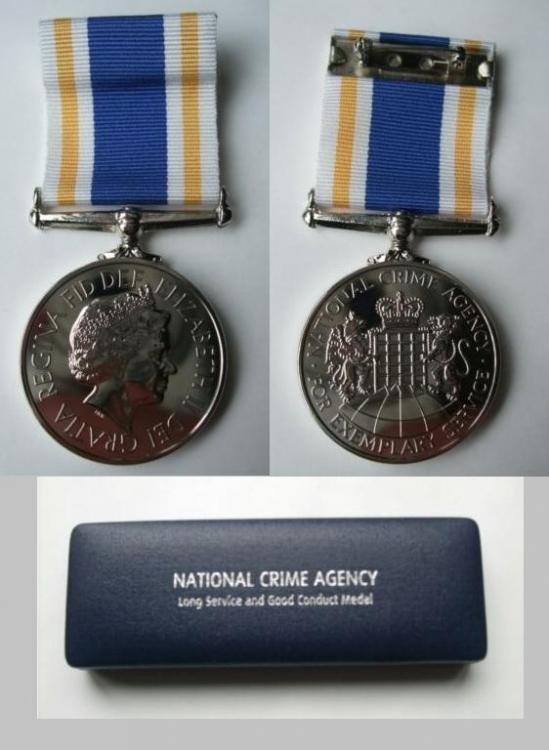

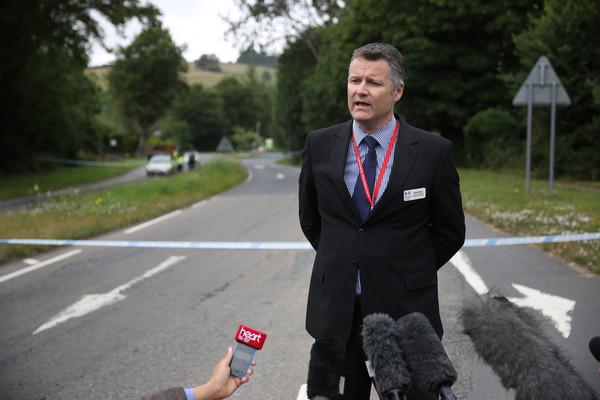
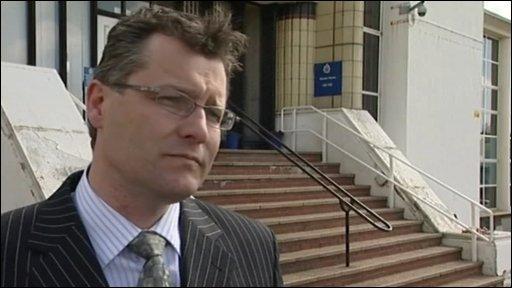
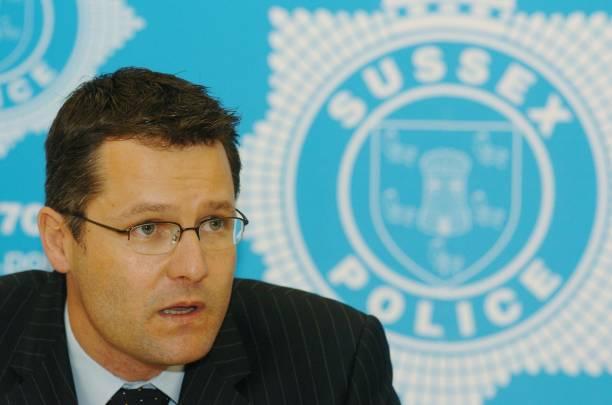

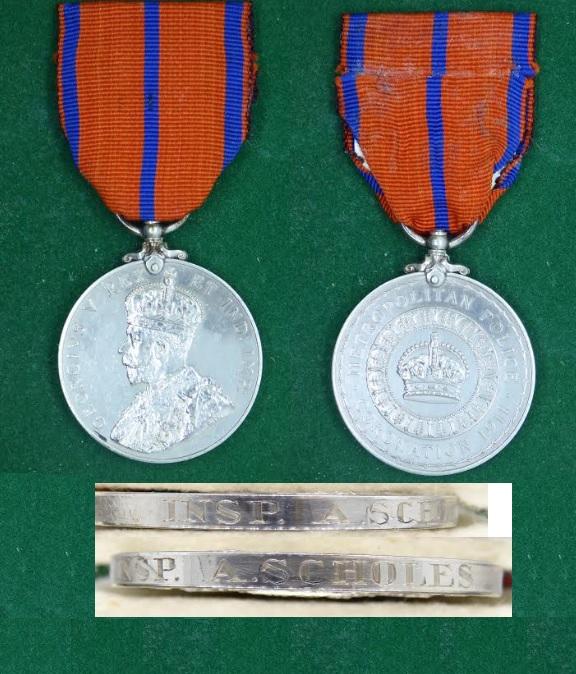


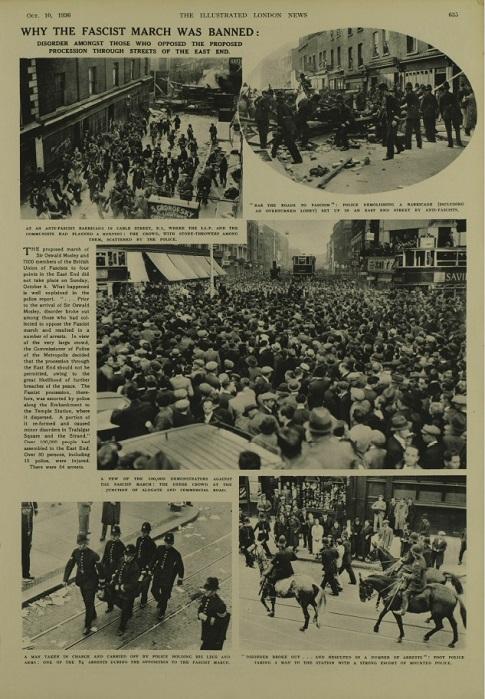
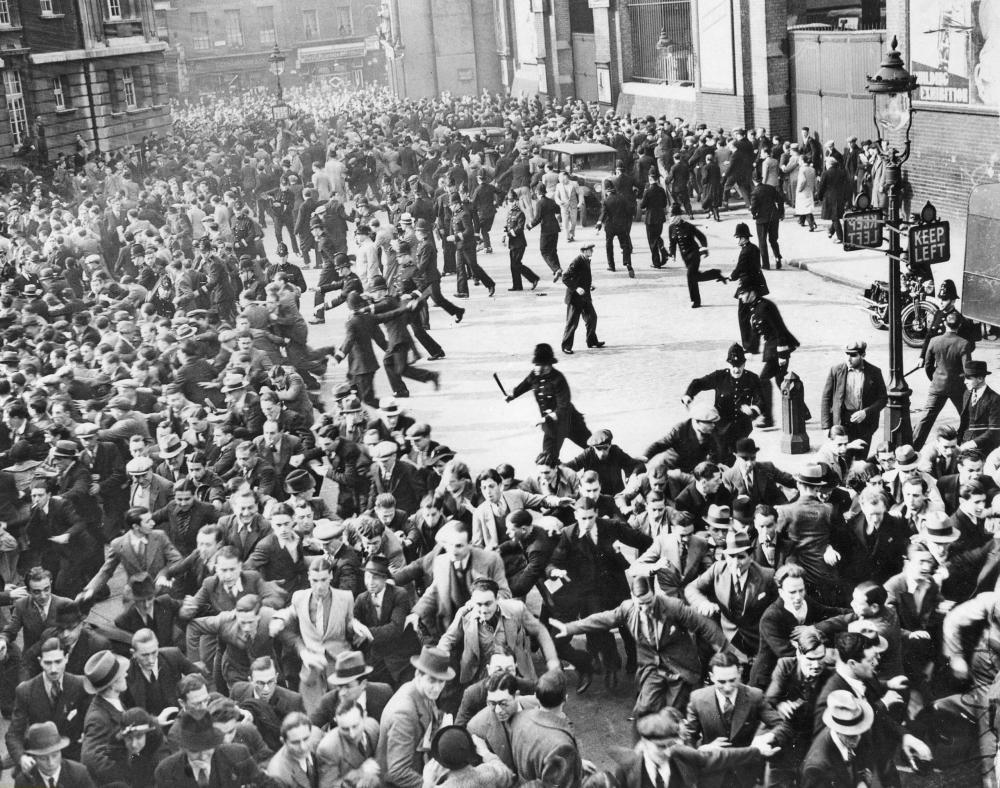
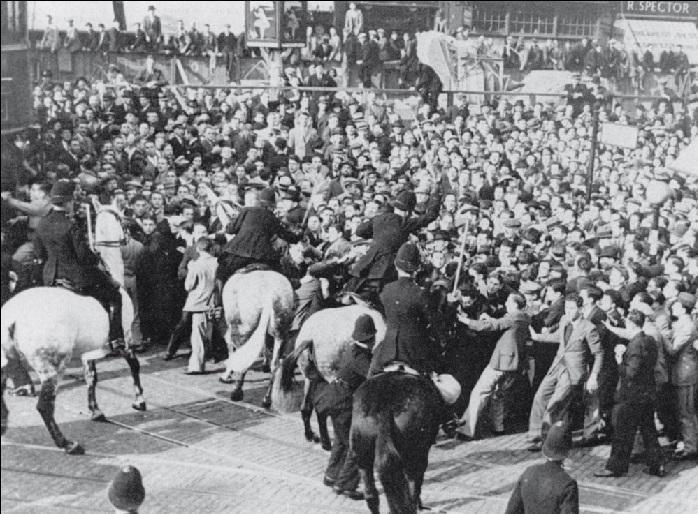
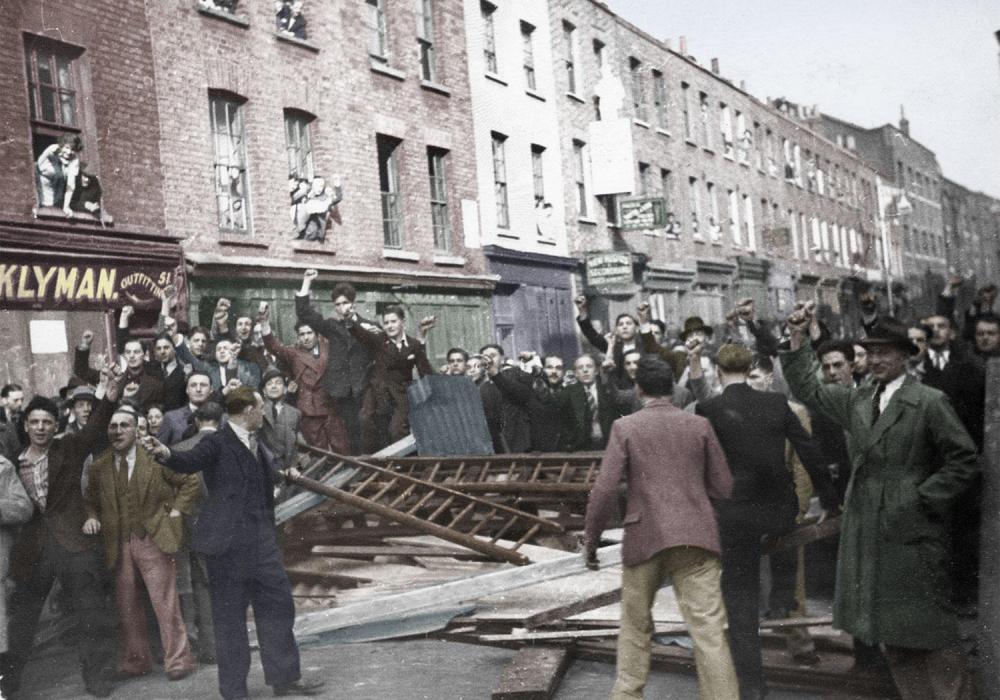
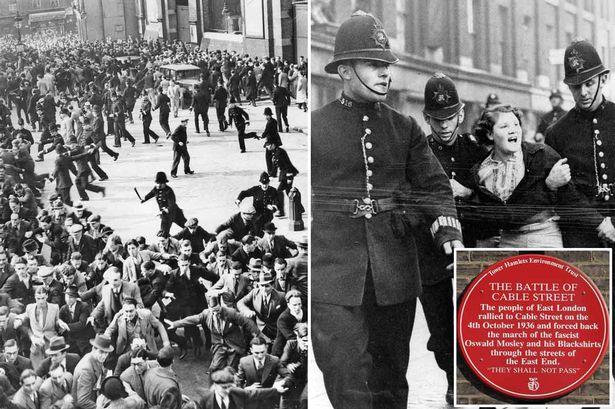

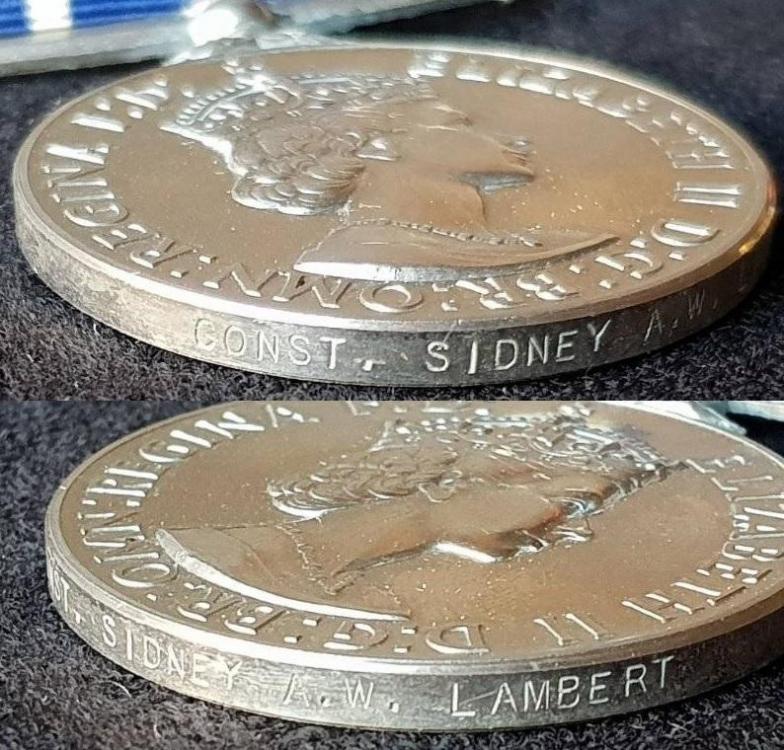


Battle of Cable Street, Whitechapel 1936
in Great Britain: Mervyn Mitton's British & Colonial Police Forces
Posted